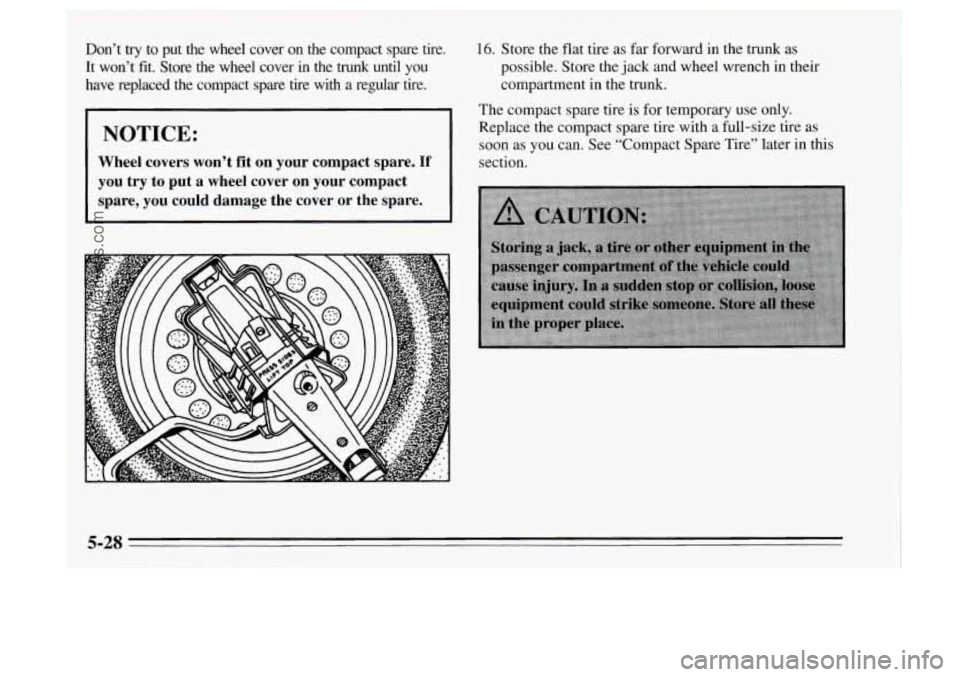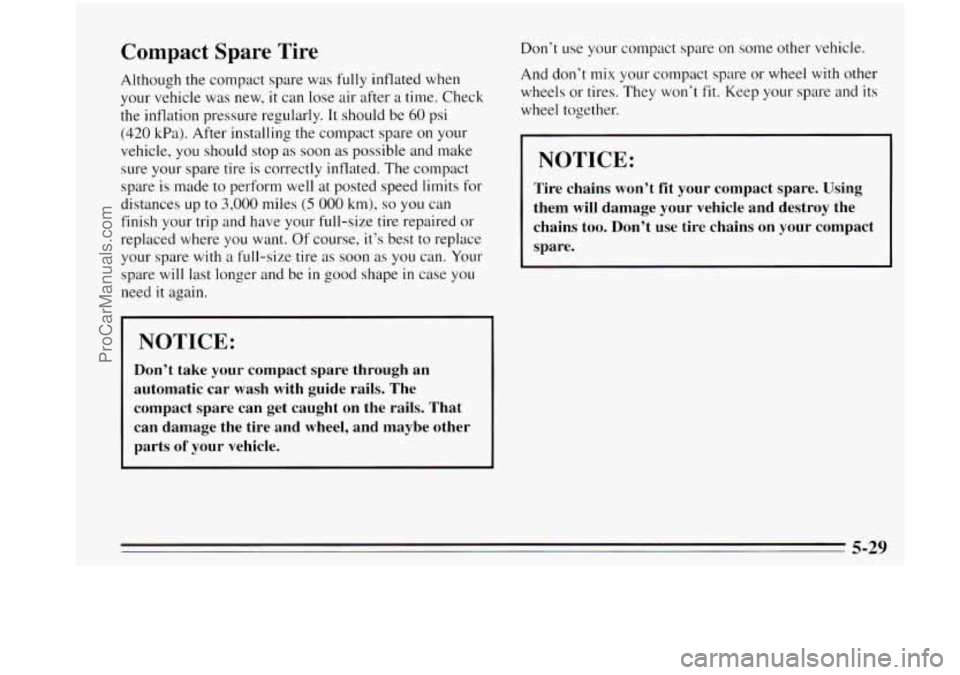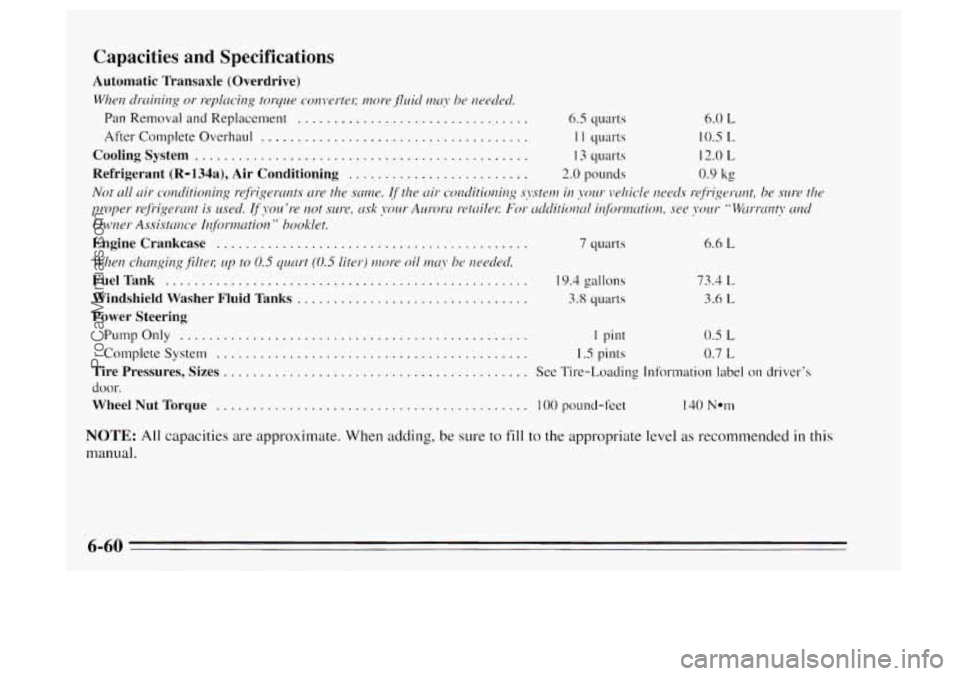tire size OLDSMOBILE AURORA 1995 Owners Manual
[x] Cancel search | Manufacturer: OLDSMOBILE, Model Year: 1995, Model line: AURORA, Model: OLDSMOBILE AURORA 1995Pages: 372, PDF Size: 19.14 MB
Page 192 of 372

Loading Your Vehicle
TIRE-LOADING INFORMATION
OCCUPANTS VEHICLE CAP. WT
FRT. CTR. RR. TOTAL
LBS. KG
MAX. LOADING & GVWR SAME AS VEHICLE
CAPACITY
WEIGHT XXX COLD TIRE
TIRE SIZE SPEED PRESSURE
RTG PSI;KPa
FRT.
RR.
SPA.
IF TIRES ARE HOT, ADD 4PSI.'28KPa
SEE OWNER'S MANUAL FOR ADDITIONAL
[ INFORMATION
Two labels on your vehicle show how much weight it
may properly carry. The Tire-Loading Information label
found on the rear edge of the driver's door tells
you the
proper size, speed rating and recommended inflation
pressure for the tires on your vehicle.
It also gives YOLI
important information about the number of people that
can be
in your vehicle and the total weight that you can
carry. This weight is called the Vehicle Capacity Weight
and includes the weight of
all occupants, cargo, and all
nonfactory-installed options.
MFD BY GENERAL MOTORS CORP
DATE GVWR GAWR
FRT GAWR RR
THIS VEHICLE CONFORMS TO ALL APPLI-
CABLE U.S. FEDERAL MOTOR VEHICLE
SAFETY, BUMPER, AND THEFT PREVENTION
STANDARDS IN EFFECT
ON THE DATE OF
MANUFACTURE SHOWN ABOVE.
The other label is the Certification label, found on the
rear edge of the driver's door.
It tells you the gross
weight capacity
of your vehicle, called the GVWR
(Gross Vehicle Weight Rating). The GVWR includes
the weight of the vehicle, all occupants, f~~el and cargo.
Never exceed the GVWR for your vehicle, or the Gross
Axle Weight Rating (GAWR) for either the
front of rear
axle.
And,
if you do have a heavy load, you should spread
it out. Don't carry more than I76 lbs. (80 kg) in your
trunk.
ProCarManuals.com
Page 228 of 372

Don’t try to put the wheel cover on the compact spare tire.
It won’t fit. Store the wheel cover
in the trunk until you
have replaced the compact spare tire with a regular tire.
NOTICE:
Wheel covers won’t fit on your compact spare. If
you try to put a wheel cover on your compact
spare, you could damage the cover or the
1 spare.
16. Store the flat tire as far forward in the trunk as
possible. Store the jack and wheel wrench in their
compartment in the trunk.
The compact spare tire is for temporary use only.
Replace the compact spare tire with a full-size tire as
soon as you can. See “Compact Spare Tire’’ later in this
section.
5-28
ProCarManuals.com
Page 229 of 372

Compact Spare Tire
Although the compact spare was fully inflated when
your vehicle
was new, it can lose air after a time. Check
the inflation pressure regularly.
It should be 60 psi
(420 kPa). After installing the compact spare on your
vehicle, you should stop
as soon as possible and make
sure your spare tire is correctly inflated. The compact
spare is made
to perform well at posted speed limits for
distances up to
3,000 miles (5 000 km), so you can
finish your trip and have your full-size tire repaired or
replaced where you want. Of course, it’s best
to replace
your spare with
a full-size tire as soon as you can. Your
spare will last longer and be in good shape in case you
need
it again.
NOTICE:
Don’t take your compact spare through an
automatic car wash with guide rails. The
compact spare can get caught on the rails. That
can damage the tire and wheel, and maybe other
parts
of your vehicle. Don‘t
use your compact spare
on some other vehicle.
And don’t mix your compact spare or wheel
with other
wheels or tires. They won’t fit. Keep your spare and its
wheel together.
I NOTICE:
Tire chains won’t fit your compact spare. Using
them will damage your vehicle and destroy the
chains too. Don’t use tire chains on your compact
spare.
5-29
ProCarManuals.com
Page 268 of 372

When it’s Time for New Tires
I
You need a new tire if: One
way to tell when it’s
time for new tires is to
check the treadwear
indicators, which
will
appear when your tires have
only
1/16 inch ( I .6 trim) or
less
of tread remaining.
a
a
a
a
0
You can see the indicators at three or more places
around the tire.
You can see cord or fabric showing through the tire’s
rubber.
The tread or sidewall
is cracked, cut or snagged deep
enough to show cord or fcbric.
The tire has
a bump, bulge or split.
The tire has
a puncture, cut, or other damage that
can’t be repaired well because
of the size or location
of the damage.
Buying New Tires
To find out what kind and size of tires you need, look at
the Tire-Loading Inforrnation label.
The tires installed
on your vehicle when it was new had
a Tire Performance Criteria Specification (TPC Spec)
nu~nber on each tire’s sidewall. When you get new tires,
get ones
with that same TPC Spec number. That way,
your vehicle
will continue to have tires that are designed
to give proper endurance, handling, speed rating,
traction, ride and other things during normal service on
your vehicle.
If yo~~r tires have an all-season tread
design, the TPC number
will be followed by an “MS”
(for mud and snow).
If you ever replace your tires with those not having a
TPC Spec number, make sure they are the same size,
load range, speed rating and construction type (bias,
bias-belted or radial) as your origiml tires.
6-38
ProCarManuals.com
Page 272 of 372

Tire Chains
NOTICE:
Use tire chains only where legal and only when
you must. Use only
SAE Class “S” type chains
that are the proper size for your tires. Install
them on the front tires and tighten them as
tightly as possible with the ends securely
fastened. Drive slowly and follow the chain
manufacturer’s instructions.
If you can hear the
chains contacting your vehicle, stop and retighten
them.
If the contact continues, slow down until it
stops. Driving too fast or spinning the wheels
with chains on will damage your vehicle.
ProCarManuals.com
Page 290 of 372

Capacities and Specifications
Automatic Transaxle (Overdrive)
Wlwn cllvrinirlg or seplcrcing tol-q~te convertel; more jlllicl n~tr~‘ bo rwederl.
Pan Removal and Replacement ................................ 6.5 quarts 6.0 L
After Complete Overhaul ..................................... I 1 quarts 10.5 L
Coolingsystem .............................................. 13 quarts 12.0 L
Refrigerant (R=134a), Air Conditioning ......................... 2.0 pounds 0.9 kg
Not trll uir conditionirlg r.efi.igel-crnts are the smw. If the nir conditiorrillg sj-steul in ~olrr vehicle Ileocls wfi-igesmt, he s1r1-e tho
proper r.cfi-igercult is used. If you ’re not ~111-e. trsk yolrr Ausoln t-etllilel: For c-tdclitionrrl i~~/i~mt~tion, .we jwrr Wirrrtrnt?* trrd
Owrwr Assistmcp Ir4fC)rmution” hooklet.
Enginecrankcase ........................................... 7 c]llasts 6.6 L
When chcmgir~g~fi’ltet; up to 0.5 qlrcu-t (0.5 liter) more oil mry be t1cecltd
FuelTank .................................................. 19.4 gallons 73.4 L
Windshield Washer Fluid Tanks ................................ 3.8 quarts 3.6 L
Power Steering
PumpOnly ................................................ 1 pint 0.5 L
Complete System ........................................... 1.5 pints 0.7 L
Tire Pressures, Sizes .......................................... See Tire-Loading Information label on driver’s
door.
Wheel Nut Torque ........................................... 100 pound-feet 140 Nom
NOTE: All capacities are approximate. When adding, be sure to fill to the appropriate level as recommended in this
manual.
6-60
ProCarManuals.com